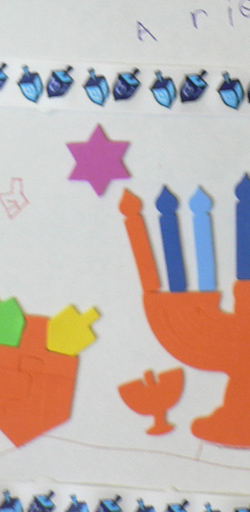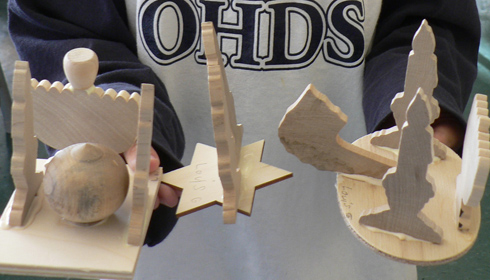The other afternoon, during ‘open studio’ time, I overheard a delightful conversation between two first grade girls. It went something like this:
Child 1 – “My Mom drew me such a good castle. She didn’t think it was good but I think she is a great draw-er.”
Child 2 – “Why was your Mom drawing for you? Why didn’t you just draw it yourself?”
Child 1 – “I don’t draw very well. My Mom is much better at it.”
Child 2 – “Well, you’ll never get better if you don’t practice. Besides, you are a really good builder, and if you do the drawing yourself, the picture would truly be yours.”
Child 2 had articulated what many of us, as teachers or parents, forget. Children need to actually do their own art work, however flawed it might appear, in order to own and learn from the experience.
Nowadays, there are so many ways that students can turn out “perfect products.” We have die cut shapes that are holiday specific, lovely wood or fabric kits for ritual wares and even velvet or translucent coloring activities. A dedicated teacher could also spend hours cutting proper shapes or perfect Hebrew letters. There is definitely a place for these activities and a time that the product is what you are after. But, we cannot delude ourselves into thinking that prepackaged materials offer a comprehensive learning adventure.
When children are given freedom to innovate their own art or craft activities, the learning opportunities abound.
 Now, I am not at all suggesting that students should be left to do whatever they please without accountability. No, what I am recommending is, that a teacher carefully consider what elements are important for students to know, what materials they could find inspiring and how the teacher can evaluate what a student has actually learned.
Now, I am not at all suggesting that students should be left to do whatever they please without accountability. No, what I am recommending is, that a teacher carefully consider what elements are important for students to know, what materials they could find inspiring and how the teacher can evaluate what a student has actually learned.
Around Hanukkah, when students come to our school art studio, they find their typical supplies (paints, crayons, assorted papers) as well as Hanukkah self-stick foam shapes, a variety of colorful foils, old greeting cards, holiday themed wood shapes and festive ribbons and yarns. It is up to each student to utilize the materials in a personally meaningful way. It is up to me to link their effort or product to the understanding I want them to demonstrate.
Sometimes a student will make it easy for me. One day last week, a fourth grader was working on a paper-cut design. When finally finished, this youngster, who used to be a frustrated perfectionist, showed me her outcome – a menorah with 3 candles on one side and 4 on the other. Rather than being distressed over her error, she eagerly explained to me that one side of the menorah was for Hanukkah, the other side represented a 7 branched menorah. There was no doubt in my mind about her knowledge! Likewise, a kindergartener had completed a collage of a hanukkiyah. This hanukkiyah featured an overabundance of candles. How easy it would have been for me to correct, or should I say “squelch” this child’s learning opportunity. Yet, this child, too, made assessment a joyous task. She brought me her art and told me, straightforwardly, that her hanukkiyah had 4 too many candles, but that it was just fine! Her statement demonstrated her learning and I could only agree, commenting, “We can all enjoy extra light!”
I must caution that, despite how simple it may sound, teaching in this fashion does not entail less teacher effort. In fact, it requires more. Instead of taking an hour or so to cut shapes or prepare stencils, teaching “in the moment” demands more background study and requires a teacher to take time to truly consider children’s work. It requires that a teacher ‘check-in’ with every student as they work, to make connections between the activity and the expected learning outcomes. It requires that each student write, dictate, or tape record an ‘artist statement’ to document the artist’s motivation, inspiration or retrospective.
Hanukkah came upon us so quickly this school year. I know that, for some teachers, the holiday crept up without enough time for elaborate planning. When this happens, you can be sure that other holidays will follow suit. As you continue through this school year, rather than spending too much time on tedious material preparation for a class set of projects, think carefully of the learning you hope to stimulate. Determine what special art materials you can add to your standard stock to bring that education from dream to reality. Endow students with the responsibility to create their own outcome for understanding. Honor independent efforts by sitting for a few minutes with every student, listening to what each hopes to demonstrate through art or craft. You can type up the artist statements to display or to send home. Indulge yourself in this kind of authentic, valuable teaching experience. You are too talented an educator to spend your energy cutting out 30 identical dreidels, or anything, shapes!


